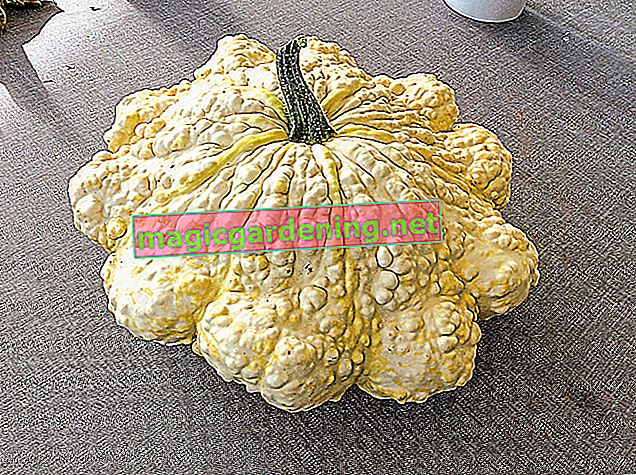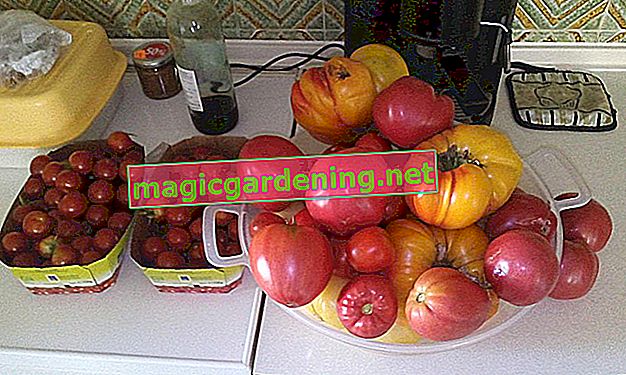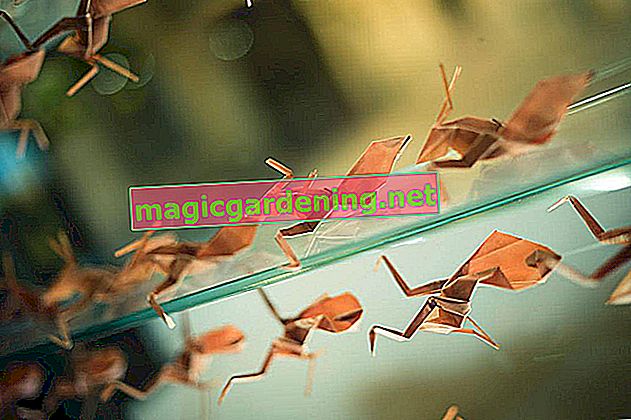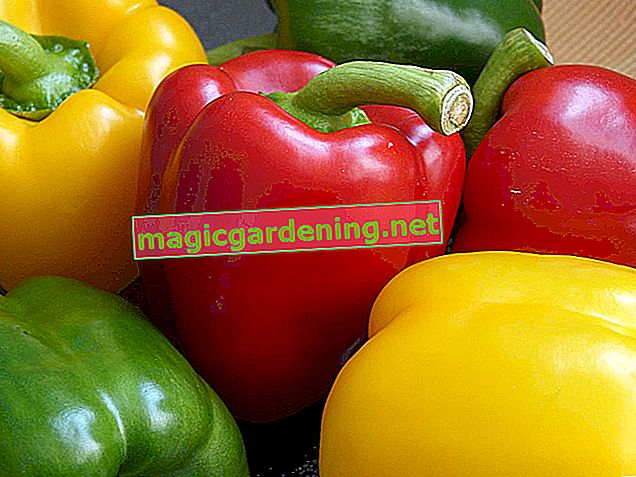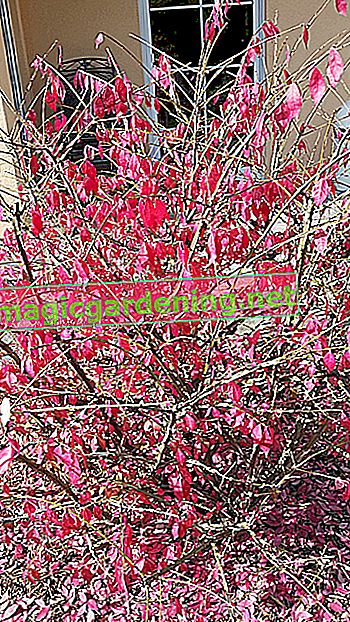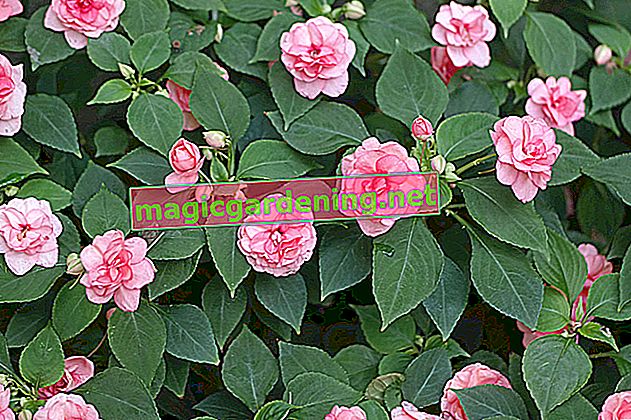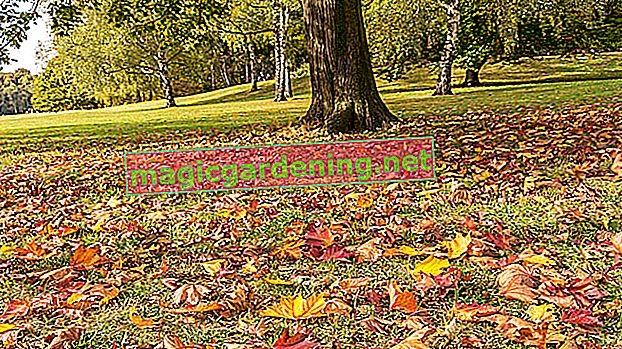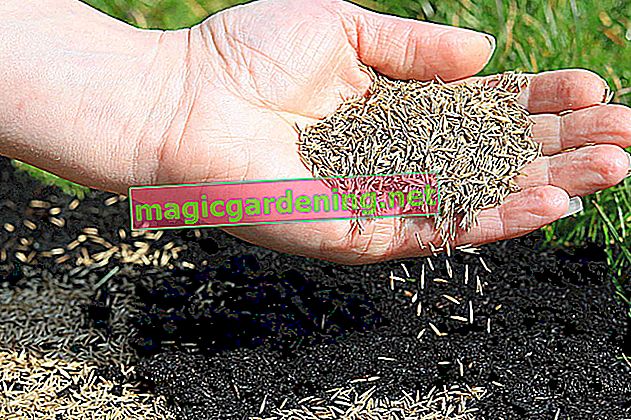
the essentials in brief
- Garden lime (€ 10.55 at Amazon *) is alkaline and thus raises the pH value, which drives away acid-loving weeds such as moss or clover
- Garden lime is applied in spring or autumn
- There are plants that do not like lime, such as azaleas or rhododendrons, that like acidic soils and therefore cannot tolerate lime
What is garden lime?
Basically, lime is a form of the chemical element calcium (Ca), which is one of the most important mineral building blocks of humans, animals and plants. So bones and teeth consist to a large extent of calcium, while the mineral in plants is an elementary component of the cell walls.
also read
- When to put the compost out
- French beans in the garden - it's worth growing
- Why it is worth growing black raspberries in the garden
In nature, calcium occurs in various types of rock and sediments, mostly in its form as calcium carbonate (CaCO3, also called carbonate of lime). This raw material is also the basis of most lime fertilizers. (€ 10.55 at Amazon *) As a rule, lime is obtained from so-called lime deposits, which are sediment deposits from the primeval oceans. Millions of years ago, the calcareous remains of marine life such as snails, mussels, crabs and others formed the basis of these rock layers. Limestone now makes up a large part of the earth's crust and serves as an important raw material for all kinds of uses in industry, home and garden.

Garden lime against moss
Moss loves acidic soils. If you have a lot of moss in your lawn, this is a sure sign that your soil is acidic. Garden lime provides a remedy here, because it is alkaline and therefore increases the pH value in the soil. It is best to apply the lime in spring and work it into the ground with a scarifier. Scarifying also brings oxygen into the soil, which moss can't stand either.
What do you need garden lime for?
Every soil naturally has a different pH value, which is a measure of the amount of hydrogen present in the soil. The pH value is displayed on a scale between 0 and 14, with a neutral soil having a value of 7. Acid soils are below, alkaline (also called basic) above. Most plants thrive best with values between 6 and 7, although there are of course also pronounced acid lovers (bog plants) or sand plants. The plants have their own preferences in this regard, which should be taken into account when choosing a location as well as with fertilization and liming.
However, the pH value of the soil is not static, but can be influenced both unfavorably and favorably. Mowing the lawn and harvesting the vegetable patch naturally lead to slow acidification, which must be counteracted by targeted liming. Over-fertilization of the soil with nitrogen-based fertilizers also leads to acidification. If the pH of the soil is too acid, this has many disadvantages for the plants:
- Availability of nutrients : Plants cannot absorb vital nutrients such as nitrogen, phosphorus and potassium in acidic soil. There is stunted growth.
- Activity of microorganisms : Bacteria and fungi cannot break down organic substances under acidic soil conditions, so that the nutrient cycle in the soil breaks down.
- Aluminum poisoning: At low pH values, aluminum dissolves, which restricts root growth and thus the availability of nutrients and water.
By liming you counteract acidification and thus deficiency symptoms.
When does the floor have to be limed?

Garden lime is an effective means of improving the soil, as it supplies the plants with calcium and also makes other nutrients available in the soil. At the same time, there is an increase in the pH value in the soil, so that you can counteract acidification by liming.
Advantages of garden lime:
- increases the pH of the soil and neutralizes acid
- supplies plants with lime
- improves the availability of nutrients
- improves the soil structure, creates fine crumbly soil
- this is important for keeping the plants in the ground and for their nutrient uptake
- promotes the activity of soil organisms
- strengthens the resistance of plants to diseases
- makes the growth of many acid-loving weeds and mosses difficult
However, garden lime not only has advantages, but also tangible disadvantages. These occur with incorrect or excessive use of the agent and reverse the positive effects of limescale in the opposite. An oversupply of lime also leads to a faster breakdown of the humus layer, which initially makes more nutrients available - but in the long run leaches out the soil. It is not without reason that an old saying goes:
"Lime first makes rich fathers and then poor sons." (Author unknown)
Digression
Not all plants like lime
When applying lime, make sure that some plants depend on an acidic environment in order to thrive. Rhododendrons, azaleas and blue hydrangeas must never be fertilized with lime.When is the right time to apply lime?
Garden lime should be applied either in early spring or in autumn, with autumn being preferable. The slow-acting lime fertilizer then has enough time over the winter months to develop its effect. Finally, in spring you give your plants a starter fertilizer, which leads to healthier and faster growth due to the better availability. Never apply lime fertilizer at the same time as nitrogen fertilizers, as this will reduce the nitrogen content.
Notes on spreading lime
Apply the garden lime either hands-free or with the help of a special spreader. The latter helps to achieve a more even distribution over larger areas. Pay attention to a wide and even distribution, also these instructions should be followed:
- Liming on dry ground
- do not sprinkle over parts of the plant, but spread directly onto the ground
- Contact with parts of plants can cause burns on leaves etc.
- work deeply into beds and borders
- Then water the lawn well
When and why you should (and when not) liming your lawn is clearly explained in this video:
YoutubeWhich lime fertilizers are there?
background
Composition of garden lime
Carbonate of lime consists of the three chemical elements calcium, carbon and oxygen. It is therefore a pure lime fertilizer, although some manufacturers also offer lime mixtures for garden fertilization. However, these are considerably more expensive than the actual garden lime, but basically have no additional use - after all, the lime primarily serves against an over-acidic soil. Fertilizing this at the same time rarely makes sense. As a rule, plants in over-acidic soils cannot absorb any nutrients anyway, so fertilization should only take place a few weeks apart.Garden lime is available in stores under very different names, with more or less similar basic ingredients being hidden behind the various brand names. However, not every type of lime is suitable for every soil. The following table clearly shows which lime you should use on which soil:
| Soil type | features | Lime type | features |
|---|---|---|---|
| rich in humus | Dead and decomposed organic material, rich in nutrients, finely crumbly, dark | carbonate of lime | natural calcium carbonate, gentle and effective for a long time |
| rich in humus | Dead and decomposed organic material, rich in nutrients, finely crumbly, dark | Algae lime | Natural lime fertilizer from red algae, contains additional nutrients, gentle and long-lasting |
| easy to moderate | sandy to loamy | Garden lime | natural calcium carbonate, versatile |
| sandy | sandy, very light, well-drained, poor in nutrients | Limestone marl | contains calcium carbonate and clay, improves soil quality in the long term |
Carbonate of lime
This is a lime fertilizer that is obtained from natural lime deposits. These include, for example:
- Chalk stone or chalk lime
- limestone
- Limestone marl
- Dolomite lime
These rocks consist mainly of calcium carbonate, which is also known as carbonate of lime. The ground limestone is particularly suitable for the garden, as it only dissolves slowly and therefore has a gentle and long-lasting effect. Dolomite lime is a type of lime that also contains magnesium and is therefore particularly suitable for plants with a higher magnesium content.
Tips
Make sure that you do not use lime fertilizers with a magnesium content of more than ten percent during regular liming. Otherwise there is an oversupply.
Algae lime
Algae lime is obtained from the dead deposits of red algae and is therefore also one of the natural types of lime. The agent contains around 70 percent calcium carbonate, up to ten percent magnesium and, in contrast to other lime fertilizers, other trace elements.
Limestone marl
This natural lime fertilizer contributes significantly to the improvement of sandy soils, as the clay it contains improves its storage capacity. With regular use, water and nutrients no longer “just run through”, but remain in the soil and can be absorbed by the plants. High-quality lime marl consists of 60 to 70 percent calcium carbonate and 30 to 40 percent clay.
Garden lime
Garden lime is not a type of rock, but the general name for various types of lime fertilizer. Usually it is ground natural lime with or without magnesium content. Sometimes garden lime also contains additives such as additional fertilizers or weed killers. Garden lime is difficult to dissolve, which is why its effect is slow and gentle.
Quick lime / unslaked lime
Quick lime or unslaked lime (calcium oxide) was still widely used in home gardens a few decades ago, but is now only found in agriculture. The substance can be mixed with water, where it reacts to form calcium hydroxide - the so-called slaked lime. Both forms take effect quickly, but are also highly aggressive. They burn skin and mucous membranes, and if used improperly, they can cause serious damage to plants and the environment. These agents are absolutely not recommended for garden liming!
Digression
Is there a difference between lawn lime and garden lime?
There are basically no differences between lawn lime and garden lime. Instead, it is actually a description of the variety, because not every garden lime fertilizer is suitable for sensitive lawns. It is best to use so-called dolomite lime for a healthy, green lawn, which is a natural fertilizer made from calcium and magnesium. Many commercially available types of lime are also mixed with slow-release fertilizers for healthy grass growth, which, however, does not always make sense. Depending on the pH of the soil, fertilization and liming should not take place at the same time.- high pH value : limescale first (preferably in autumn), fertilize in spring
- New creation of a lawn : when sowing grass seeds, fertilize as well as lime
- neutral pH value : even with maintenance liming, liming and fertilization can be carried out at the same time
Test the lime content of the soil
For this reason, you should always check the pH of your garden soil before applying lime fertilization. To do this, you can take soil samples and send them to a specialized laboratory (and at the same time receive precise fertilizer recommendations), but you can also carry out the test at home. Specialized lime checker sets are available for this in specialist shops, which you can use even without basic chemical knowledge. However, the disadvantage of home use is that you will not receive any fertilization or liming recommendations. Instead, you have to calculate the correct amount of lime yourself.
Pointer plants
Certain plants - so-called pointer plants - also give you a clear indication of whether your soil is more acidic or alkaline. These plants feel at home in very specific soil conditions and thus show the pH value at their location without any test. The following table lists some of the most common species in the home garden.
| These pointer plants indicate acidic soil | These pointer plants like lime |
|---|---|
| Mosses | Bellflower |
| Hare clover | Wiesenknopf |
| Field chamomile | Chicory |
| Little sorrel | Nettle |
| Field horsetail | Germander |
| Sand pansy | Goose thistle |
| Wood sorrel | Adonis |
| Farm mustard | Coltsfoot |
| Yellow exuberant flower | dandelion |
| Honorary award | Dead nettle |
| daisy | Cranesbill |
Deficiency symptoms are an indication of hyperacidity
Yellowed leaves, dried out shoot tips or brownish spots on the pulp: All these deficiency symptoms often indicate over-acidification of the soil. But not only, because these phenomena also occur with waterlogging or general nutrient deficiency (e.g. due to insufficient fertilization).
Digression
Are rock flour and garden lime the same thing?
Garden lime is pure calcium carbonate, which is sometimes enriched with magnesium. Meanwhile, rock flour (€ 14.95 at Amazon *) is exactly what the name suggests: finely ground rock. This is more or less calcareous depending on the type of rock, but also contains a number of other minerals and trace elements. For this reason, rock flour can hardly be overdosed, while fertilization with garden lime has to be measured precisely - over-fertilization can have drastic consequences for the fertility of the soil.frequently asked Questions
Does lime also help against snails?
In fact, a ring of carbonate or garden lime around an endangered plant can protect it from voracious slugs. The animals generally avoid crawling over what is for them sharp-edged and drying out material.
Is lime actually toxic to dogs?
Do not let your pets - not only dogs, but also cats and rodents such as guinea pigs, rabbits and turtles - run over freshly limed ground or lawn. The agent may have a caustic effect and can lead to injuries. If whitewashed grass is eaten, poisoning is very likely, especially in small animals.
Tips
Eggshells contain lime, but they are not suitable as a substitute for garden lime. Nevertheless, you can use them as an inexpensive fertilizer for house and balcony plants and of course in the garden. Let the crushed eggshells soak in tap water for a few days and then water your plants with it. Calculate two to three eggshells per liter of water.

